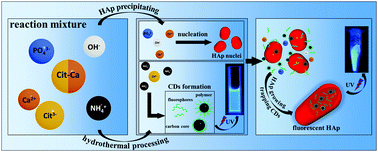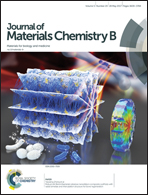Investigation of luminescent mechanism: N-rich carbon dots as luminescence centers in fluorescent hydroxyapatite prepared using a typical hydrothermal process†
Abstract
Defect-related fluorescent HAp materials, which require no toxic metal ions or photobleaching fluorescent organic dyes, are expected to be excellent fluorescent probes in biological fields. However, the luminescent mechanism is poorly understood, making it difficult to adjust their emission performance for better applications in bioimaging. Herein, a novel luminescent mechanism for defect-related HAp fluorescent materials obtained from a typical hydrothermal process was revealed. N-Rich carbon dots (CDs), rather than the reported CO2˙−, were confirmed as the luminescence centers responsible for self-activated luminescence. The mode in which the N-rich CDs and HAp host combined might be through CDs (mainly polymer clusters and/or molecular fluorophores constituents) becoming trapped in the HAp crystal structure. This study should inspire the design of fluorescent HAp materials with tunable fluorescence emissions due to the diverse synthetic methods and tunable fluorescence emission of CDs.



 Please wait while we load your content...
Please wait while we load your content...